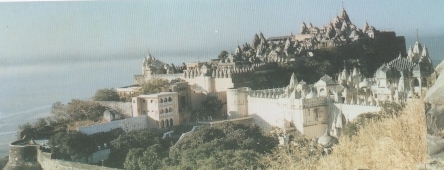 |
|
Shatrunjaya-Palitana Tirtha Gujarat |
 |
Jain tirthas are of two types:
There are perhaps a couple of hundred major and minor tirthas. Many,
like Shatrunjaya-Palitana, are "temple-cities".
Shatrunjaya enclosure is spread over nine hill tops and about 20
acres. How many temple are at Shatrunjaya? Depends on how you count. Some
say 108, the "Lonely Planet" Guide mentions 863, others say
about 3500. There are many "chauvisis"
(set of 24 small identical shrines). Actually there are 108 large temples
and 872 small shrines with about 7000 images total. The main temple is
dedicated to lord Rishabha.
Shatrunjaya is assocoated with the Nirvana of Pundarika, son of Bharata
(the Chakravarti, after whom India is named Bhaarat) and grandson and Ganadhar
of Rishabh, the first Jina (also called Adi-nath).
The main sources of the tradition associated with the mountain are
"Saravali" (perhaps written in 11th century) and Vividha-tirtha-kalpa
(14th cent.) etc. The tirtha has been rebuilt many times. According to
VTK, the 14th rebuilding (uddhaar) was done by Vagbhatta, a Minister of King
Kumarpal in VS 1220, however according to Shatrunjaya Rasa, the 14th
rebuilding was by BahaDade Munhate, son of a minister of Kumarpal. In both
accounts, the builder was the son of Udayan of Shrimal jnyati. It was
destroyed in VS 1369 by Allauddin Khilji.
Later rebuldings occurred in VS 1371, 1587 and 1649.
In 16th century, Hiravijaya Suri of Tapa-Gachchha met Akbar and obtained
the grant of the hill. The main shrine of Adi-nath by Tejpal Soni was built in
VS 1649 under the direction of Hiravijaya Suri. This gave the impetus to
proliferation of shrines on the hill.
In 1656 AD the village Palitana was granted to Shantidas Jhaveri, leader
of the Jain community by Muradbaksh, the governer of Gujrat. In 1730 AD,
the management was assigned to Anadji Kalyanji trust.
Archaeology: The oldest available object on the hill is an idol of
Pundarika (he was not a Tirthankar, but since he obtained moksha, he can be
worshiped) installed in 1006 AD. Since it is mentioned in the Shvetambara
canonical books, it was already a famous tirtha by the fifth century.
Yashwant
I thank Anil Visariya for providing some of the information on this page.
(Note that VS (Vikrama Samvat)= AD + 57 approximately)